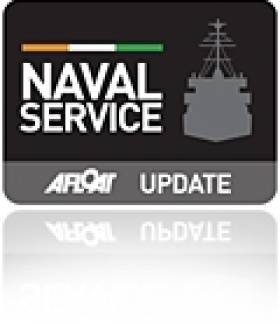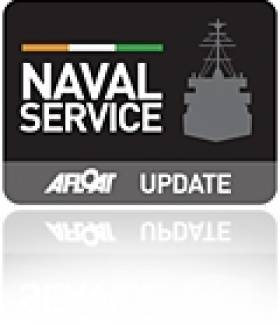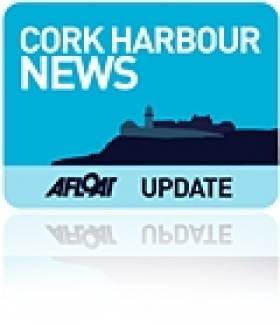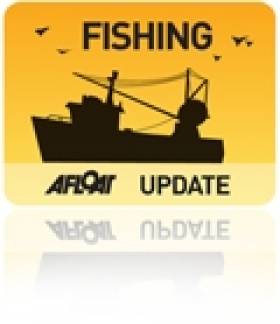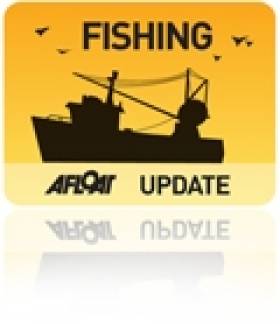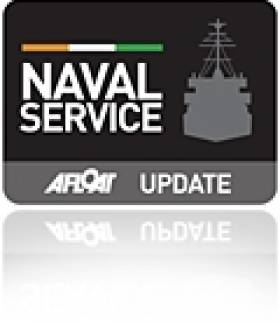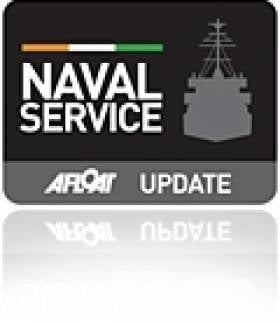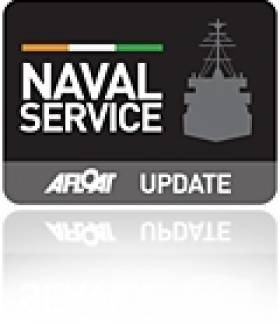Displaying items by tag: naval service
#EithneMedCrisis - Naval Service HPV LÉ Eithne (P31) writes The Irish Times is to be dispatched to the Mediterranean Sea to participate in an EU search and rescue mission for migrants fleeing north Africa, the Minister for Agriculture, Food and Marine has said.
Simon Coveney told RTÉ radio this Tuesday morning he hoped the LÉ Eithne would be ready to leave for the Mediterranean by (this) Friday, May 8th.
He said the vessel was being prepared in Haulbowline naval base in Cork harbour so that it could "successfully save people and drop them to local ports in the vicinity of the Mediterranean".
Mr Coveney said the Taoiseach was anxious to respond to the crisis in southern Europe by providing " humanitarian and emergency rescue response capacity".
The European Union has been struggling to forge a united response to the migration crisis currently sweeping across the Middle East and north Africa as desperate migrants flee their homes for refuge in Europe.
No decision has yet been made on Ireland's participation in a European pilot resettlement programme for migrants.
#NavyMedCrisis - For first time Ireland is to participate in an EU search and rescue mission, following the Government's decision to send a fully crewed ship to the Mediterranean to help with the rescue of migrants fleeing north Africa.
The ship could be dispatched within weeks, officials said, and will work alongside Triton, the EU's search and rescue mission in the Mediterranean.
EU leaders have agreed to triple the funding allocated to Triton, with German chancellor Angela Merkel pledging to commit more money if necessary, in order to alleviate the humanitarian crisis in the Mediterranean.
"If we need more money we will put up more money. We will not fail because of lack of funds," the German chancellor said in Brussels.
For much more on this story, The Irish Times reports HERE.
#OPVJamesJoyce – The Naval Service lastest newbuild James Joyce is currently dealing with technical issues, though the Department of Defence in response to Afloat.ie say the OPV is due for delivery in the coming weeks, writes Jehan Ashmore.
She is the second of a trio of OPV90 class newbuilds that were ordered from Babcock Marine in the UK that saw L.E. Samuel Beckett (P61) enter service last year.
The north Devon shipyard is working on addressing the technical issues of James Joyce following recent completion of sea trails, noting the first sea-trials took place last month.
Previously it was understood that the newbuild was to make a delivery voyage to Cork Harbour last month.
James Joyce is a direct replacement of the former 'Aoife' which was decommissioned last January after a career spanning 35 years.
#haulbowline – Marine minister Simon Coveney says there has been no final decision taken on an 'Ocean Yacht Racing Hub' within the Naval Service base at Haulbowline island in Cork Harbour.
In this morning's Irish Times newspaper, marine correspondent Lorna Siggins writes that a British yacht racing consultancy has met Government agencies as part of a 'grand plan' for haulbowline island, site of a former steelworks site. The plan for the yacht base was first mooted by British solo racer Alex Thomson when he called into to Cork Harbour for repairs last April before heading across the Atlantic Ocean.
As Afloat.ie reported last October, Thomson, together with his shore manager Stuart Hosford, a Cork native, returned to the harbour and gave a public lecture about his solo sailing success that also included comment about the potential to develop the harbour site. The visit was part of an 'Innovation Week' in Cork where Cork Institute of Technology, the Irish Naval Service and University College Cork promoted the first Imerc Innovation Week.
Interest in the Haulbowline site focuses on the substantial graving dock where large yachts measuring up to over 100–foot in length or more could be lifted in an out of the water in a deep water environment with convenient access to the Atlantic.
Haulbowline has been making headlines for years because of cancer-causing residue, left over from the Irish Steel plant that once occupied the land. It has been confirmed that a cache of 500,000 tonnes of slag and toxic waste material were buried at the former steelworks. Afloat reported on the hot site in the harbour in 2011.
More in the Irish Times on the Yacht Hub story here.
Owners of Dutch 'Supertrawler' Consider Appeal On €105,000 Fine
#SupertrawlerAppeal - The Irish Times reports that the head of the company that owns the world's largest trawler said on Sunday that his board is considering appealing a €105,000 fine imposed by an Irish court.
Diederik Parlevliet, managing director of Dutch firm Parlevliet and Van der Plas which owns super-trawler Annelies Ilena, complained the skipper was ordered to pay "a vastly unproportionate" sum for a €30 breach of the law.
That's what he claimed the amount of illegal fish was worth on the trawler, which is a half-metre longer than pitch in Croke Park.
The Irish Navy and Sea Fisheries Protection officers boarded the 144.6-metre Annelies Ilena off Tory Island in November 2013. For more on this story, click HERE
In addition to reading more by Lorna Siggins of The Irish Times (yesterday) who reflected on the arrest of the supertrawler, the former Irish owned 'Altantic Dawn' and the background to the current test case for EU fishery Law.
Largest Vessel: Dutch 'Supertrawler' Arrested by Naval Service
#SupertrawlerArrest - Lorna Siggins of The Irish Times reflects on the 922nd boarding by a Naval Service fishery patrol in 2013 which could have been a routine affair, but for the vessel's size and history.
The 144-metre Dutch-registered Annelies Ilena is seven times the tonnage of the patrol ship, LÉ Roisín (P51) – and multiple times that of the rigid inflatable (RIB) deployed by Lieut Cdr Terry Ward to inspect it.
The ship, formerly the Irish-registered Atlantic Dawn, is one of the world's biggest fishing vessels, the largest super trawler and the biggest detention by the Naval Service to date.
It was among a fleet of Dutch vessels working some 100 nautical miles northwest of Tory Island when approached by a joint Naval Service/Sea Fisheries Protection Agency (SFPA) patrol on November 22nd, 2013.
The team intended to board several in the fleet in the knowledge that such ships flying other EU flags were notoriously hard to inspect. If caught, it could also be a test case for EU fishery law.
"Vessels with the ability to catch fish on an industrial scale in waters under our jurisdiction, but which almost never land here, pose particular challenges to ensure regulatory compliance," SFPA chair Susan Steele said at the time.
Had it been 20 miles north, it would have been in Scottish waters.
It was detained and escorted to Killybegs, Co Donegal, on suspicion of "high grading", a practice initiated, ironically, in response to stricter EU quota regulations. It involves retaining the most valuable fish and throwing smaller, less valuable, fish which are still over the minimum size back into sea.
For supertrawlers, it can make the difference of several hundred thousand euro per trip.
For much more on this story, click here.
#CommodoreBrett – In the obituaries page of The Irish Times: Commodore Liam Brett who has died aged 86, retired as the head of the Irish Navy in 1990.
As a seafarer, he was renowned for his ship handling and his ability to manoeuvre and turn vessels in the tightest of locations. As an officer, he was seen as firm but fair. In his leadership he displayed understanding and compassion and he enjoyed the respect of those he commanded.
William John Brett was born into a farming family in Cappauniac, Cahir, Co Tipperary, the second youngest of the 11 children of Thomas Brett and Bridget Pyne. After primary education at Ballydrehid National School, Kilmoyler, he attended the Christian Brothers School in Tipperary town.
He entered the Irish Naval Service in 1947, and joined the the Naval cadet class a year after the establishment of the service, at a time when training meant moving to the centre of British naval education on the south coast of England – a long way from his landlocked native county.
He received his midshipman training with the Royal Navy at Britannia Royal Naval College, Dartmouth. Sea time on board British ships allowed him to travel widely, from the home waters around Europe as far afield as Hong Kong, gaining valuable experience in the years immediately after the second World War.
For more about his career involving corvettes and the capture of the 'Claudia' click here.
Govt Donated LÉ Aoife Despite €500K Offer
#Navy - An offer to purchase the decommissioned Naval Service vessel LÉ Aoife for half a million euro was not taken up by the Government, it has emerged.
RTÉ News reports that a Waterford-based marine engineer made the offer on behalf of a Dutch client with a view to using the OPV for security operations in Africa.
The deal, offered over a year ago, would have been worth far more than the €320,000 for which her sister ship LÉ Emer sold at auction in 2013.
That vessel was recommissioned last month into the Nigerian Navy as NNS Prosperity.
But the prospective purchasers say they never heard back from the Department of Defence, and only learned of the State's donation of the LÉ Aoife to Malta through the media.
RTÉ News has more on the story HERE.
#Navy - Forty-three new Naval Service recruits join a sea defence fleet that's "the most modern in its history", as the Irish Examiner reports from this week's passing out parade.
The 41 men and two woman saluted their commanding Flag Officer Hugh Tully at the ceremony at Naval Service Headquarters on Haulbowline Island in Cork Harbour on Thursday 12 March.
Awards were also presented to the new class, including best shot (to 26-year-old Gary O'Connor), best kit (to 27-year-old Darren Lawlor) and best recruit, which went to 25-year-old local man Shane Downey.
The Irish Examiner has more on the story HERE.
Aoife’s Malta African Refugee Role? Almost Full Circle!
#AoifesFate? – Aoife's fate still remains as the former Naval Service OPV is according to the Department of Defence in active discussions with the Maltese authorities, writes Jehan Ashmore.
The department added, that negotiations in relation to the modalities to be agreed in relation to the transfer of ownership of the decommissioned LÉ Aoife (P22).
Should the 1979 built Aoife head for a new career in the Med with the Armed Forces of Malta (AFM) naval squadron (and despite the 'junk' comments) one of new roles would be to assist in the humanitarian crisis.
Be it to deploy 'Aoife' to assist in the effort to rescue refugees fleeing worn-torn regions of North Africa and beyond. In addition to migrants seeking a better life in Europe having taken to the water on boats also organised by people-traffickers.
Could this be somewhat full-circle for the former Naval Service patrol-ship? As the following is a piece I wrote for the Maritime Institute of Ireland's (National Maritime Museum of Ireland) Newsletter Winter 2003/04 and under the heading: Uniquely 'Unique'.
The story read: When going to work on November 5th, I noticed an unusual looking vessel at anchor south-east of Dun Laoghaire in Dublin Bay.The ship was a small coaster and of some vintage too and had characteristics unusual for ships calling to Dublin Bay these days.
It transpired that the vessel, the Mongolian registered 'Unique' was suspected of people-trafficking, as widely reported by the media. This activity turned out to be the first suspected incident of such a case in Irish waters.
The Naval Service L.E. Aoife arrived on November 6th in order to undertake inspections on board the Unique.
Despite searches of the ship and crew, no illegal persons or contraband where found. The Unique was subsequently escorted to Dublin Port on November 13th by the L.E. Ciara.
An Admiralty Court order for non-payment of wages for the crew of Unique were issued on behalf of the International Transport Federation (ITF).
It is now ironic to reflect on that historic incident of suspected people-trafficking and to have involved the deployment of L.E. Aoife from the 8-strong naval fleet.
As the Aoife is no longer in service, the fleet is reduced to 7 patrol vessels until newbuild OPV90 class James Joyce (on sea-trials) enters service this Spring?
As previously reported on Afloat.ie, Cork County Councillors call for Aoife to remain in the southern city as a floating museum. This would see the former OPV vessel as a museum near the Naval Service Base on Haulbowline, Cork Harbour, in the face of what's been taken as a "snub" by the Maltese.
A similar idea to keep Aoife in Irish waters was floated previously by a lobby group in Waterford. They campaigned for the veteran vessel to be kept along Waterford's quays and during her Naval Service days they designated the OPV's adopted 'homeport' to be that city. Aptly the south-eastern city is to where her decommissioning took place in January.
Aoife is currently berthed at the Naval Base. As for her exact location at the HQ's island complex, it is understood she is berthed within the Naval Basin alongside the former Irish Steel Plant. It is from this western quay of the basin is where the steel-plant received cargoships with scrap metal!
So watch this space and to wherever next?



























